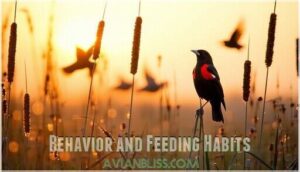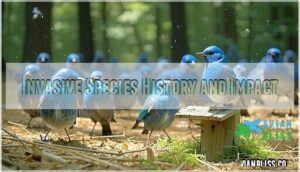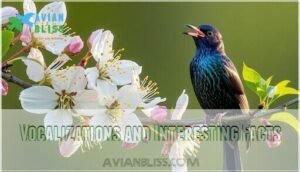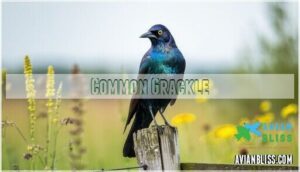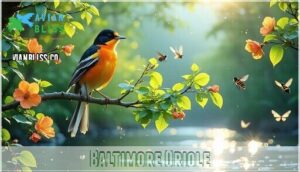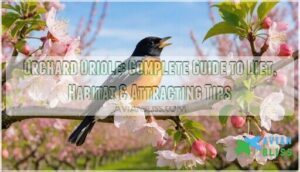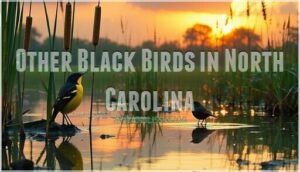This site is supported by our readers. We may earn a commission, at no cost to you, if you purchase through links.

The red-winged blackbird flashes bright shoulder patches in wetlands, while common grackles strut with rainbow-colored feathers that shimmer like oil on water.
European starlings chatter noisily in flocks, and brown-headed cowbirds sneak their eggs into other birds’ nests.
Baltimore orioles bring splashes of orange, contrasting their black heads beautifully.
You’ll also spot orchard orioles, rusty blackbirds, and boat-tailed grackles across different habitats.
Each species has unique tricks for survival that’ll surprise you once you know what to look for.
Table Of Contents
- Key Takeaways
- Types of Blackbirds in North Carolina
- Red-winged Blackbird
- European Starling
- Brown-headed Cowbird
- Common Grackle
- Baltimore Oriole
- Orchard Oriole
- Rusty Blackbird
- Boat-tailed Grackle
- Other Black Birds in North Carolina
- Frequently Asked Questions (FAQs)
- What kind of black birds are in NC?
- What are these black birds in my yard?
- Are blackbirds good to be in your yard?
- Are there other black birds besides crows?
- What time of year do blackbirds migrate?
- How can I attract blackbirds to feeders?
- Are blackbirds harmful to crops or gardens?
- What diseases do blackbirds commonly carry?
- How do blackbirds survive harsh winter weather?
- Conclusion
Key Takeaways
- You’ll find nine distinct black bird species in North Carolina, including red-winged blackbirds with bright red shoulder patches, common grackles with iridescent feathers, and European starlings that form massive flocks
- These birds occupy diverse habitats from wetlands to urban areas – red-winged blackbirds dominate marshes, while starlings thrive in cities and brown-headed cowbirds roam open fields
- Each species has unique survival strategies like the cowbird’s brood parasitism (laying eggs in other birds’ nests) and Baltimore orioles’ preference for sweet nectar and fruit
- You can attract these birds to your yard with appropriate feeders and food – sunflower seeds and cracked corn work well, while orioles prefer grape jelly and orange halves
Types of Blackbirds in North Carolina
North Carolina’s diverse habitats support nine distinct black bird species, each with unique plumage variation and habitat preferences.
You’ll find these adaptable birds thriving across wetlands, grasslands, and forests throughout the state. Red-winged blackbirds dominate marshes with their scarlet shoulder patches, while brown-headed cowbirds roam open fields.
From scarlet-winged marsh defenders to open-field wanderers, North Carolina’s blackbirds rule diverse landscapes with stunning adaptability.
European starlings form massive flocks in urban areas, and common grackles strut through backyards with iridescent feathers. Migration patterns vary dramatically – some species stay year-round while others travel thousands of miles.
Diet differences range from seeds and insects to fruits and nectar. Understanding these North Carolina birds‘ conservation status helps protect their habitats.
Learning to identify black bird species transforms ordinary birdwatching into exciting discoveries of nature’s remarkable diversity. Some may even witness a raptor rehabilitation effort while observing these birds.
Red-winged Blackbird
You’ll spot male Red-winged Blackbirds easily by their glossy black feathers and bright red shoulder patches that flash like warning signals when they fly.
These common marsh birds weigh just 1-3 ounces but defend their wetland territories with surprising aggression during breeding season.
Identification and Range
You’ll spot Red-winged Blackbirds across North Carolina’s wetlands year-round, though they’re less common in mountain regions during winter.
These black birds showcase dramatic plumage variations between sexes and seasons.
- Male identification: Look for glossy black feathers with bright red shoulder patches edged in yellow
- Female identification: Notice streaky brown plumage with white wing bars and pale breast
- Size comparison: Medium-sized at 6.7-9.1 inches long with 12.2-15.8 inch wingspan
- Seasonal changes: Males develop duller plumage in winter while retaining red patches
Their habitat preferences include marshes, ponds, and cattail stands.
Regional distribution spans all NC counties, making them essential north carolina birds for any nc bird guide focused on black bird species and bird identification.
Behavior and Feeding Habits
Red-winged blackbirds are opportunistic feeders with impressive diet adaptations.
You’ll find them foraging in cattails for insects, seeds, and aquatic invertebrates.
Their social interactions include territorial displays where males spread their scarlet shoulder patches.
These black birds form large flocks during migration patterns, especially in fall.
Watch their bird behavior at feeders where they dominate smaller species.
Their bird feeding habits shift seasonally – breeding rituals focus on protein-rich insects for nestlings, while winter bird diet emphasizes grains and seeds from agricultural areas, showcasing their ability to adapt to different diet adaptations.
European Starling
You’ll recognize European Starlings by their glossy black feathers that shine with green and purple highlights during breeding season.
These chunky birds originally came from Europe in the 1890s and now compete with native species for nesting sites across North Carolina.
Invasive Species History and Impact
European Starlings arrived in North America in 1890 and reached North Carolina by 1919.
These invasive species now threaten our native birds through aggressive competition for nesting sites and resources. They’re highly adaptable birds, thriving in diverse environments.
- Habitat Disruption – Starlings outcompete native cavity-nesters like bluebirds for homes
- Agricultural Impact – Flocks damage crops and contaminate livestock feed
- Disease Transmission – Carry pathogens affecting wildlife and humans
- Control Measures – Management programs target problem populations but complete removal remains unlikely
Vocalizations and Interesting Facts
Listen carefully to European Starlings and you’ll discover their remarkable birdsong complexity. These black birds showcase incredible mimicry abilities that’ll surprise you.
They copy other north carolina birds like cardinals and robins with startling accuracy. Their call variations include melodic whistles, harsh clicks, and chattering sounds that change throughout the day.
You might hear them imitating car alarms or cell phone ringtones – their vocal learning skills are that advanced. During breeding season, males perform elaborate songs combining dozens of different bird calls and environmental sounds.
This unique behavior helps them attract mates and defend territory. European Starlings can learn new vocalizations throughout their lives, unlike many songbirds.
Their brain structure allows continuous vocal adaptation. Watch flocks communicate through complex bird sounds that coordinate feeding and roosting activities.
These remarkable birds demonstrate that intelligence and adaptability often accompany invasive success in North Carolina’s diverse ecosystems.
Brown-headed Cowbird
You’ll easily recognize Brown-headed Cowbirds by their unique appearance – males sport glossy black bodies with chocolate-brown heads while females wear plain brown feathers.
These clever birds have mastered one of nature’s most controversial survival strategies by laying their eggs in other birds’ nests instead of raising their own young, which is a clever approach to ensure their species’ survival.
Brood Parasitism Behavior
Brown-headed Cowbird’s sneaky strategy makes them master brood parasites among North Carolina birds.
Nature’s ultimate freeloaders: cowbirds make other birds raise their kids while they kick back and relax.
These crafty blackbirds don’t build their own nests.
Instead, they practice brood manipulation by sneaking eggs into unsuspecting hosts’ homes.
Here’s how their parasitic habits work:
- Cowbird Impact: Female cowbirds lay up to 40 eggs per season across multiple host nests
- Host Defenses: Some species like Gray Catbirds reject cowbird eggs over 95% of the time
- Parasite Success: Cowbird chicks hatch faster and outcompete host babies for food
- Evolutionary Arms Race: Over 220 North American bird species serve as unwilling foster parents
This breeding strategy creates an ongoing battle between Brownheaded Cowbirds and their hosts.
Cowbirds have expanded their range due to human-altered landscapes.
Thought-provoking Question
Have you ever wondered how your own actions ripple through nature’s delicate web?
Just like brown-headed cowbirds disrupting other species’ nesting success, human activities create lasting impacts on black birds in North Carolina.
Habitat loss from development affects migration patterns and forces these intelligent creatures to adapt or perish.
Conservation efforts become essential when we recognize our role in shaping wildlife communities across the state, and understand the importance of preserving nature’s delicate web.
Common Grackle
Looking at these magnificent black birds with their glossy feathers and piercing yellow eyes, you’ll quickly recognize common grackles as one of North Carolina’s most prominent types of black birds.
Key Grackle Identification Features:
- Size and Color – Large black birds (11-13 inches) with iridescent blue-green sheen and bright yellow eyes
- Behavior – Travel in large flocks, often aggressive at feeders, walk rather than hop
- Habitat – Found in parks, suburban areas, agricultural fields, and wetlands across NC
Grackle Diet and Behavior
These adaptable omnivores eat everything from insects and seeds to small fish and eggs. Their Grackle Sounds include harsh calls and squeaks that echo through neighborhoods. During breeding season, males display by puffing up their feathers and spreading their tails.
Grackle Habitat spans urban and rural areas throughout North Carolina. You’ll spot grackles in NC year-round, especially around bird feeders where their Grackle Behavior can dominate smaller species. Their intelligence and adaptability make them successful bird grackles in diverse environments.
Baltimore Oriole
You’ll spot Baltimore Orioles in North Carolina during spring and summer when they arrive to breed and raise their young.
These striking orange and black birds prefer sweet treats like fruit, nectar, and grape jelly, making them frequent visitors to backyard feeders stocked with their favorite foods, especially backyard feeders.
Preferences for Fruit and Nectar
Beyond traditional bird feeding habits, Baltimore Orioles showcase fascinating foraging behavior when seeking fruit nutrition and nectar sources.
These black birds demonstrate remarkable dietary flexibility throughout seasonal availability periods. You’ll discover their dietary impact extends beyond simple bird food preferences.
Bird diet studies reveal orioles actively target sugar-rich options like grape jelly, orange halves, and flowering trees. Their specialized black bird diet includes both cultivated fruits and wild berries, making them delightful backyard visitors with distinct feeding patterns.
To best attract them, consider using specialized nectar feeders to take advantage of their love for nectar sources and fruit nutrition.
Personal Experience With Baltimore Orioles
You’ll discover that creating an oriole-friendly backyard brings rewarding moments throughout the migration seasons.
These tips enhance your Baltimore Oriole attraction success:
- Oriole Nesting Habits: Hang baskets near tall trees for potential nest sites
- Feeding Preferences: Offer grape jelly and orange halves consistently
- Backyard Attractants: Plant native fruit trees and maintain water sources
- Seasonal Behavior: Watch for peak activity during spring migration
Consider purchasing oriole favorites to increase visits.
Orchard Oriole
You’ll recognize the Orchard Oriole by its smaller size compared to the Baltimore Oriole. Males sport striking chestnut plumage with black wings and head, while females display yellow-green coloring.
These members of the Icteridae family arrive in North Carolina during spring migration, with males establishing territories first. Their breeding habits involve constructing hanging pouch nests from grasses and plant fibers.
Females weave these intricate structures in tree branches, typically oaks in open woodlands. The nest construction process takes several days of careful weaving.
Diet preferences include insects, nectar, and fruit. They’re skilled at catching flying insects and often visit flowering trees. Their conservation status remains stable, though habitat loss affects some populations.
Plumage variation between sexes makes identification straightforward. Listen for their bubbling song during breeding season. Among North Carolina’s bird orioles, they’re the earliest fall migrants, departing by September.
Rusty Blackbird
You’ll spot the Rusty Blackbird’s distinctive rusty-brown plumage during North Carolina’s winter months, a stark contrast to breeding males’ glossy black feathers.
These medium-sized black birds show remarkable plumage changes throughout seasons, with non-breeding birds displaying rusty edges on their feathers and pale yellow eyes that catch your attention.
Unfortunately, Rusty Blackbirds face severe black bird decline – their populations have plummeted over 85% in recent decades.
Habitat loss from wetland drainage devastates their preferred swampy winter roosts in North Carolina’s coastal plains.
Their conservation status remains precarious, listed as Near Threatened.
You’ll find these secretive blackbirds foraging in wet woodlands and flooded forests, their diet variation including insects, seeds, and small aquatic creatures.
They probe leaf litter with slender bills, often joining mixed flocks with other bird blackbirds.
Protecting wetlands becomes essential for these vulnerable migrants.
Boat-tailed Grackle
While the Rusty Blackbird struggles with declining numbers, the Boat-tailed Grackle thrives along North Carolina’s coast.
These striking birds showcase remarkable sexual dimorphism – males are nearly twice the size of females and sport glossy blue-black plumage with that signature keel-shaped tail.
You’ll find Boat-tailed Grackles exclusively in coastal habitats, rarely venturing more than ten miles inland.
Their vocalizations include harsh, grating calls that echo across salt marshes and beaches.
Here’s what makes these grackles unique:
- Urban feeding – They’re bold scavengers who’ll snatch food from parking lots and beach picnics
- Social behavior – Males defend harems of females during breeding season
- Aquatic diet – They pry open mussels and dunk bread in water before eating
- Year-round residents – Most stay within ten miles of their birthplace
Watch for their distinctive strutting walk with tails cocked high as they forage across mudflats and marshes.
They’re opportunistic feeders, similar to the common grackle’s diet, consuming insects, seeds, and even garbage.
Other Black Birds in North Carolina
North Carolina’s diverse landscape attracts several rare blackbirds beyond the common species. Migration patterns bring unexpected visitors during spring and fall seasons. You might spot a Yellow-headed Blackbird among cattails or catch a glimpse of the secretive Brewer’s Blackbird with its glossy plumage.
These uncommon black bird sightings create special moments for nc wildlife enthusiasts. Habitat loss affects many species, making conservation efforts increasingly important for protecting migration corridors. One might even spot a falcon, as rare raptors visit the state.
Here are five reasons these rare encounters matter:
- Discovery moments – Finding an unexpected species fills you with pure excitement
- Conservation awareness – Each sighting highlights the need to protect natural spaces
- Connection to nature – These birds link you to vast migration networks spanning continents
- Scientific contribution – Your observations help researchers track population changes
- Memory making – Rare encounters become treasured stories you’ll share for years
When identifying black birds, listen for birdsong variations that distinguish species. Different types of black birds prefer specific habitats, so exploring various environments increases your chances of spotting these remarkable visitors.
Frequently Asked Questions (FAQs)
What kind of black birds are in NC?
You’ll find several black birds calling North Carolina home, each with their own feathered drama.
Common grackles strut with glossy purple-blue plumage, while red-winged blackbirds flash crimson shoulder patches during territorial disputes.
What are these black birds in my yard?
Common black birds you’ll see include Red-winged Blackbirds with bright red shoulder patches.
Glossy Common Grackles with yellow eyes, European Starlings with speckled plumage, and Brown-headed Cowbirds where males sport chocolate-colored heads are also common.
Are blackbirds good to be in your yard?
One songbird devours up to 1,000 insects daily.
Blackbirds, known for their appetite for snails, slugs, and beetles, are especially helpful in controlling slug and snail populations.
You’ll benefit from their natural pest control services.
Are there other black birds besides crows?
Yes, you’ll spot many black birds beyond crows in North Carolina.
Red-winged blackbirds flash red shoulder patches, while brown-headed cowbirds sport chocolate-colored heads.
European starlings shimmer with iridescent feathers, and common grackles show off bright yellow eyes.
What time of year do blackbirds migrate?
When do these feathered travelers take flight?
Most blackbirds migrate during spring and fall periods.
Red-winged blackbirds head south in September through November and return March through May.
Brown-headed cowbirds follow similar patterns but some overwinter in milder regions, exhibiting a behavior related to migration.
How can I attract blackbirds to feeders?
You’ll attract blackbirds by offering sunflower seeds, cracked corn, and suet in platform or tube feeders. Place feeders near water sources and keep them consistently filled for best results.
Are blackbirds harmful to crops or gardens?
Blackbirds can damage crops like corn and sunflowers but they’re generally beneficial.
They eat tons of harmful insects and weed seeds.
You’ll find they’re nature’s pest control team working overtime in your garden.
What diseases do blackbirds commonly carry?
Common diseases you’ll find in blackbirds include salmonellosis through droppings and saliva, over 60 diseases and parasites, psittacosis from inhaling dust containing feathers, and avian influenza through contact.
How do blackbirds survive harsh winter weather?
Many blackbirds tough out winter by flocking together for warmth, switching to high-energy foods like seeds and berries, and seeking shelter in dense vegetation or roosting communally in protected areas.
Conclusion
Picture a birdwatcher who started with just one field guide and now identifies dozens of species by sound alone.
That’s the journey you’re beginning with black birds in North Carolina. These nine species offer endless opportunities for observation and discovery.
From wetland red-winged blackbirds to sneaky cowbirds, each has adapted uniquely to Carolina’s diverse habitats.
Start with one species, learn its habits, and gradually expand your knowledge. Soon you’ll spot these fascinating black birds everywhere you look.
- https://www.carolinabirdclub.org/BOCC/Passerines/22%20Blackbirds,%20Grackles,%20Cowbirds,%20Meadowlarks,%20Orioles/Brewer's%20Blackbird.pdf
- https://www.nps.gov/articles/black-rail-inventory-at-national-seashores.htm
- https://nc.audubon.org/news/state-proposal-highlights-threats-facing-three-nc-bird-species
- https://digitalcommons.unl.edu/cgi/viewcontent.cgi?article=1676&context=icwdm_usdanwrc
- https://www.wunc.org/environment/2024-01-30/triangle-north-carolina-bird-population-decline-loss-climate-change


